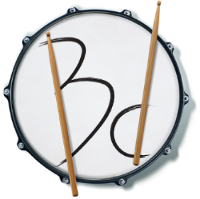Rhythms of the Holiday Season
‘Tis the season! The season of holiday music. People seem to either love it or hate it with very little middle ground. You’ve likely heard hundreds of different renditions of classic seasonal music at the grocery store, mall, or any place a lot of people pass through, particularly between Thanksgiving and New Year’s Eve. But have you ever tried to analyze the rhythms within these songs? How about create drum parts based around the rhythms of the lyrics or melody? Let’s check out the rhythms of some exceptionally popular holiday music.
Jingle Bells
First up, we’ll break down the rhythm of the chorus from the song “Jingle Bells.” You can very likely hear the tune in your head, but we’re going to work out exactly what’s happening in musical terms by throwing all of the pitches out the window and focusing on only the rhythms.
The main portion of the song (the chorus) consists mostly of quarter notes and 8th notes, with only a few 16th notes throughout. Technically, there are a couple of half notes, but since we’ll play on only the snare drum, we don’t need to worry about the sustain of the sound. The rhythm of the chorus is written below.
We could also map this rhythm between the kick and snare to make it all function more as a groove that directly supports the melody and lyrics. Playing consistent 8th notes on the hihats, keeping a steady backbeat (playing the snare drum on beats 2 and 4), and playing the rest of the rhythm on mostly the bass drum is a good place to start when it comes to a groove interpretation. Catching the crash cymbal with the snare on beat 4 in the 4th measure is a good way to support the enthusiastic “Hey!” in the lyrics. Check out the below video to hear everything demonstrated!
Frosty the Snowman
Next, we’ll crack into “Frosty the Snowman.” Rhythmically, it’s somewhat similar to “Jingle Bells,” but with a few more 16th notes. Some of the lyrics anticipate the downbeat, meaning the phrase begins just before beat 1. In this case, most of the lyrical phrases begin on the ‘&’ of beat 4. Having lyrics anticipate the downbeat often results in utilizing more natural speech cadences and helps the words better fit within the music.
And just like we did with “Jingle Bells,” we can map this rhythm between the kick and snare while keeping time on the hihats to turn it into a groove. Subtle hihat embellishments (such as opening the hihats a touch) help to better engage with the rest of the music during the short pauses between the lyrics.
We Wish You a Merry Christmas
“We Wish You a Merry Christmas” has a unique feel compared to the other two. Most notably, this song is in a 6/8 time signature instead of 4/4, or common time. 6/8 consists of 6 8th notes per measure, which is typically articulated as 2 stronger beats with 3 parts each. It’s often felt as “1 2 3 4 5 6,” where beats 1 and 4 are emphasized compared to the others. Additionally, this song begins with a pickup measure consisting of a single 8th note. A pickup measure is a fraction of a measure, typically no more than one or two beats, that precedes the song’s first downbeat. In this case, the first “We” of the lyrics functions as the pickup. Check out the notation below to see how the lyrics fit within the rhythm.
When applying everything to the drum set, the rhythm can still be split between the kick and snare the same way as before. In 6/8 however, the backbeat is usually felt on beat 4, instead of beats 2 and 4 like with common time. This particular interpretation is much busier on the bass drum, but is certainly not the only way the rhythm can be expressed on the drum set.
From here, try decoding the rhythms of other songs you like and see if you can create your own drum set parts to support them. This approach works particularly well for songs that don’t already have drums! Using the rhythm of a song’s lyrics is a great starting point and a solid way to guide decisions you make when it comes to orchestrating such rhythms around the drums.







